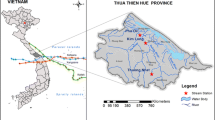Abstract
The continuous torrential rain associated with a typhoon often caused flood, landslide or debris flow, leading to serious damages to Taiwan. Thus, a usable scheme to forecast rainfall amount during a typhoon period is highly desired. An analysis using hourly rainfall amounts taken at 371 stations during 1989–2001 showed that the topographical lifting of typhoon circulation played an important role in producing heavier rainfall. A climatology model for typhoon rainfall, which considered the topographical lifting and the variations of rain rate with radius was then developed. The model could provide hourly rainfall at any station or any river basin for a given typhoon center. The cumulative rainfall along the forecasted typhoon track was also available. The results showed that the R2 value between the model estimated and the observed cumulative rainfall during the typhoon period for the Dan-Shui (DSH) and Kao-Ping (KPS) River Basins reached 0.70 and 0.81, respectively. The R2 values decreased slightly to 0.69 and 0.73 if individual stations were considered. However, the values decreased significantly to 0.40 and 0.51 for 3-hourly rainfalls, indicating the strong influence of the transient features in producing the heavier rainfall. In addition, the climatology model can only provide the average conditions. The characteristics in individual typhoons should be considered when applying the model in real-time operation. For example, the model could give reasonable cumulative rainfall amount at DSH before Nakri (2002) made landfall on Taiwan, but overestimated the rainfall after Nakri made landfall and weakened with significant reduction in convection.
Similar content being viewed by others
References
Barnes, S. L.: 1973, Mesoscale objective analysis using weighted time-series observations. NOAA Tech. Memo. ERL NSSL-62, National Severe Storms Lab., Norman OK 73069, 60 pp. [NTISCOM-73-10781].
R. W. Burpee M. L. Black (1989) ArticleTitleTemporal and spatial variations of rainfall near the centers of two tropical cyclones Mon. Weather. Rev. 117 2240–2218
C. P. Chang T. C. Yeh J. M. Chen (1993) ArticleTitleEffects of terrain on the surface structure of typhoons over Taiwan Mon. Weather. Rev. 121 734–752
J. P. Charba Y. Liu M. H. Hollar B. Exley A. Belayachi (1998) ArticleTitleGridded climatic monthly frequencies of precipitation amount for 1-, 3-, and 6-h periods over the conterminous Unites States Weather Forecast. 13 25–57
J. P. Charba D. W. Reynolds B. E. McDonald G. M. Carter (2003) ArticleTitleComparative verification of recent quantitative precipitation forecasts in the national weather service: A sample approach for scoring forecast accuracy Weather Forecast. 18 161–183 Occurrence Handle10.1175/1520-0434(2003)018<0161:CVORQP>2.0.CO;2
W. M. Frank (1977) ArticleTitleThe structure and energetics of the tropical cyclone. I. Storm structure Mon. Weather Rev. 105 1119–1150
D. L. Fread R. C. Shedd G. F. Smith R. Farnsworth C. N. Hoffeditz L. A. Wenzel S. M. Wiele J. A. Smith G. N. Day (1995) ArticleTitleModernization in National Weather Service river and flood program Weather Forecast. 10 477–484 Occurrence Handle10.1175/1520-0434(1995)010<0477:MITNWS>2.0.CO;2
W. M. Gray (1981) Recent Advances on Tropical Cyclone Research from Rawinsonde Composite Analysis World Meteorological Organization Geneva 407
J. A. Knaff M. DeMaria C. R. Sampson J. M. Gross (2003) ArticleTitleStatistical, 5-day tropical cyclone intensity forecasts derived from climatology and persistence Weather Forecast. 18 80–92 Occurrence Handle10.1175/1520-0434(2003)018<0204:AH>2.0.CO;2
Lee, C. S.: 1993. A preliminary analysis of two typhoons when moving across Taiwan, Proceedings of the Second Conference on East Asia and Western Pacific Meteorology and Climate, World Scientific, Singapore (pp. 205–212).
Y. L. Lin S. Chiao T. A. Wang M. L. Kaplan R. P. Weglarz (2001) ArticleTitleSome common ingredients for heavy orographic rainfall Weather Forecast. 16 633–660 Occurrence Handle10.1175/1520-0434(2001)016<0633:SCIFHO>2.0.CO;2
M. Lonfat D. Frank Jr. Marks S. Shuyi Chen (2004) ArticleTitlePrecipitation distribution in tropical cyclones using the tropical rainfall measuring mission (TRMM) microwave imager: A global perspective Mon. Weather Rev. 132 1645–1660 Occurrence Handle10.1175/1520-0493(2004)132<1645:PDITCU>2.0.CO;2
Q. Mao S. F. Mueller H. M. H. Juang (2000) ArticleTitleQuantitative precipitation forecasting for the Tennessee and Cumberland River watershed using the NCEP Regional Spectral Model Weather Forecast. 15 29–45 Occurrence Handle10.1175/1520-0434(2000)015<0029:QPFFTT>2.0.CO;2
F. D. Marks (1985) ArticleTitleEvolution of the structure precipitation in Hurricane Allen (1980) Mon. Weather Rev. 113 909–930
D. Rosenfeld D. B. Wolff E. Amitai (1994) ArticleTitleThe window probability matching method for rainfall measurements with radar J. Appl. Meteorol. 33 682–693 Occurrence Handle10.1175/1520-0450(1994)033<0682:TWPMMF>2.0.CO;2
Wang, S.-T.: 1992, An Integrated Study of the Impact of the Orography in Taiwan on the Movement, Intensity, Structure, Wind and Rainfall Distribution of Invading Typhoons, Technical Report 80–73, S&T of the Multiple Hazards Mitigation Program, NSC, Taiwan, 285 pp (in Chinese).
T. C. Yeh S. C. Wu S. L. Shieh (1999) ArticleTitleA study of typhoon rainfall statistics forecast over Taiwan area. Part I: Methods and the forecast evaluations over Taipei Atmos. Sci. 27 395–412
T. C. Yeh (2002) ArticleTitleTyphoon rainfall over Taiwan area: The empirical orthogonal function modes and their applications on the rainfall forecasting TAO 13 449–468
Author information
Authors and Affiliations
Corresponding author
Rights and permissions
About this article
Cite this article
Lee, CS., Huang, LR., Shen, HS. et al. A Climatology Model for Forecasting Typhoon Rainfall in Taiwan. Nat Hazards 37, 87–105 (2006). https://doi.org/10.1007/s11069-005-4658-8
Issue Date:
DOI: https://doi.org/10.1007/s11069-005-4658-8



